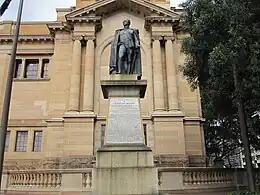Church Act 1836
The Church Act, also known as the Church Building Act,[2] was a 1836 law in the Colony of New South Wales. It was drafted by John Plunkett and enacted by the Governor, Sir Richard Bourke.[3] It was subtitled "An Act to promote the building of Churches and Chapels and to provide for the maintenance of Ministers of Religion in New South Wales."[4]

The statue of Sir Richard Bourke outside the State Library of New South Wales notes in its inscription that he "established religious equality on a just and firm basis".[1]
The Act established equitable funding for Church of England, Church of Scotland, and Roman Catholic churches. It thus led to the effective disestablishment of the Church of England.[5][6] Bourke later extended the provisions of the Act to Methodist and Baptist churches, as well as the Jewish community.[7]
References
- "Sir Richard Bourke". Monuments Australia. Retrieved 20 October 2023.
- "Church Building Act 1836 No 7a". Australasian Legal Information Institute. Retrieved 20 October 2023.
- Suttor, T. L. (1967). "Plunkett, John Hubert (1802–1869)". Australian Dictionary of Biography. Vol. 2. National Centre of Biography, Australian National University. ISSN 1833-7538. Retrieved 15 September 2020.
- Oliver, Alexander (1879). A Collection of the Statutes of Practical Utility, Colonial and Imperial, in Force in New South Wales. p. 160. Retrieved 20 October 2023.
- "Bourke Church Act". Defining Moments. National Museum of Australia. Retrieved 20 October 2023.
- Ngui, Samantha (2008). "Freedom to worship: frameworks for the realisation of religious minority rights". University of New South Wales. p. 40. Retrieved 20 October 2023.
- "The Church Act, 1836". State Library of New South Wales. Retrieved 20 October 2023.
Further reading
This article is issued from Wikipedia. The text is licensed under Creative Commons - Attribution - Sharealike. Additional terms may apply for the media files.